| | Stages of labor | Correction of dystocia | Assisting the birth of a large calf | Important principles of helping at a difficult calving | Care of the calf | Care of the cow | Retained placenta
It is not unusual to encounter problems during the calving process. Often these problems can be more easily solved if the producer has more knowledge of the physiological process of calving. There are two common presentations for the calf during calving. The first, which is normal and occurs in about 95 per cent of calvings, is the one in which the calf comes forward with the head tucked between its front legs with its nose a few inches from the tips of the toes.
The second most common presentation is not considered to be normal because of the high incidence of dystocia (calving problems) associated with it. The calf comes backwards with the hind feet first and the legs fully extended. Backwards presentation only occurs in about 5 per cent of calvings. In the case of twins, one calf is often presented backwards with the other one forward.
Dystocia can occur when there are deviations from the above presentations. Postural changes from those described above, e.g., a foot or leg turned back, require correction before delivery can take place, and this should be done as soon as it is recognized. Any delay will only make the situation worse because the labor contraction of the dam will wedge the malpositioned calf more firmly into the birth canal and make corrections more difficult. If trouble is suspected, determine the nature of the problem as soon as possible and take suitable action to correct it without delay.
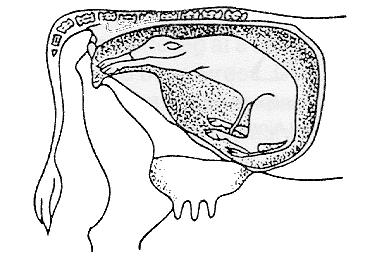
Figure 1. Normal presentation
Stages of Labor
The first stage of labor is the preparation for birth, During this stage, which takes from three hours in a cow to 72 hours in a first-calf heifer, the ligaments of the pelvis and associated structures relax. The cervix, vagina and vulva all dilate and the cervical mucous plug is released. All these changes are to facilitate the passage of the calf. Interference before this stage is completed should be avoided because dilation of the cervix will be incomplete, making it susceptible to irreparable damage.
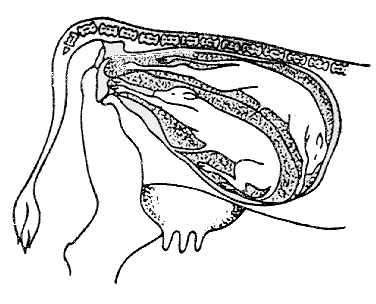
Figure 2. Normal presentation of twins (If assistance is necessary, be sure to correctly identify the legs of each calf.)
During the first stage of labor, the cow will become restless and often want to separate from the herd. She may stand with her tail raised and back arched and occasionally may even make some premature attempts at straining. The start of the second stage of labor is signalled by the appearance of the water bag.
The second stage of labor is the expulsion of the calf through the birth canal. Duration of this stage lasts from one-half hour in the cow to two or three hours in a first-calf heifer, A cow or heifer should be given no more than one hour after the water bag appears before being checked to see if she needs help.
Expulsion of the fetal membranes (placenta) and involution of the uterus (getting ready for the next pregnancy) comprise the third stage of labor. The placenta is usually expelled within a few hours of birth but complete involution of the uterus takes up to 40 days after calving.
Correction of Dystocia
It is important to be very clean when attempting to correct a dystocia and the vulva of the cow should be washed thoroughly with a mild soap or disinfectant solution. The operator's hands and arms should also be scrubbed clean.
If you find upon inserting your hand into the vagina that the cervix will admit only two or three fingers, the case is probably one of nondilation of the cervix or possible uterine torsion. You may possibly be interfering too soon. If not, call a veterinarian who may elect to perform a caesarian operation.
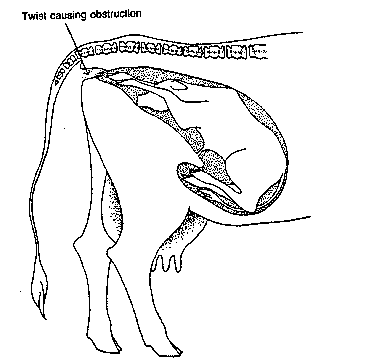
Figure 3. Uterine torsion
If the cervix is fully dilated and three essential parts of the calf (two forefeet and head or two hind feet and tail) can be felt in proper position, the problem may be one of uterine inertia and moderate traction may be applied. Bear in mind, however, that if the uterine inertia is caused by prolonged efforts at calving, there is the danger of the uterus having ruptured, in which case your veterinarian should be called immediately.
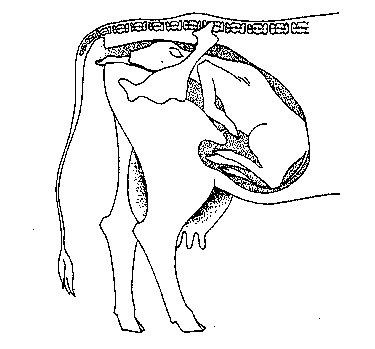
Figure 4. One foreleg back. If necessary, push the head back into uterus, then bring the forefoot into normal position.
Sometimes deviations of the feet or head are minor and simple to correct, at other times they may be very difficult and necessitate veterinary assistance as soon as possible. In any case, always be gentle, as you are dealing with living tissue which can be injured easily. Any abnormal posture in the calf should be corrected before attempting to pull the calf in order to avoid severely injuring the cow or calf.
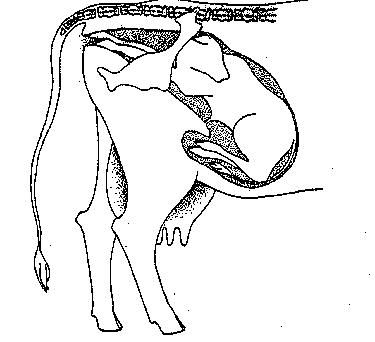
Figure 5. Head turned sideways.
A breech presentation (see figure 6) may be very difficult to correct particularly if the cow has been in labor for some time. Extreme care must be taken when straightening the hind limbs to avoid tearing the uterus by the toes or the hocks of the calf. It is extremely important to work on straightening the calf's legs between bouts of straining and to stop trying to manipulate parts of the calf while the cow is straining. This will minimize the risk of tearing the uterus.
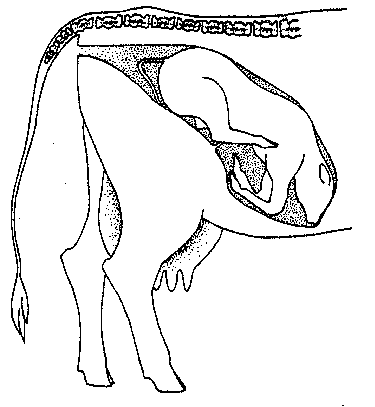
Figure 6. Breech presentation (hind legs forward) Carefully push the calf forward and bring the hind legs into the birth canal.
If the calf is coming backwards, never attempt to turn the calf to a forward presentation. If the calf is positioned correctly, pull it. After the legs are exposed, complete the delivery as quickly as possible. Delay at this time may result in a dead calf because it will start to breathe very soon after its navel cord is pinched in the birth canal. Since the calf's mouth and respiratory passage may have become filled with uterine fluid from involuntary gasping, hold the calf up by the hind legs for a few moments immediately following delivery and make sure all fluid is drained out. Hanging the calf for a prolonged period should be avoided as fluid from the stomach will start to drain out of the mouth and may be aspirated into the lungs as the calf gasps and tries to breathe.
Assisting the Birth of a Large Calf
Proper obstetrical chains and handles (or clean nylon ropes) are very good for assisting with the birth of a calf. They are easy to apply or remove and, most importantly, they are easy to clean and disinfect. The use of dirty ropes or twine should be avoided. Remember that chains or ropes must be applied properly to minimize damage to the limb. Always apply a chain or rope to the leg with a loop above the fetlock (first joint) with a half hitch below the fetlock (figure 7). Failure to do this may result in a broken limb on the calf which will not heal well even if put in a cast. Never apply a rope or chain calving around the calf's jaw but rather through the mouth and around the back of the head behind the ears. This will prevent a broken jaw.

Figure 7. Attachment of calving chain or rope
Lubrication of the birth canal and your hands and arms with a good commercial lubricant, obtainable from your veterinarian, will greatly facilitate the delivery of a large calf.
It is vital that you work with the cow, timing your pulling with straining or contractions. As well, follow the natural lines of calf delivery, making use of both the natural curvature of the calf and the birth passage. This means puling in a horizontal or slightly upward direction until the head and trunk (chest) are delivered and then in a downward direction towards the cow's hocks until delivery is complete.
Advance only one leg at a time and be satisfied with only an inch or tow of progress. Don't hurry. Allow time for the birth passage to fully expand. A well-lubricated hand used in a "shoe horn fashion" may help in the delivery of the head.
If a hiplock occurs (figure 8), try to free the calf by rotating it in the birth canal. Do this by wrapping a sack around the exposed part of the calf's body and turning it 90 degrees in either direction. Failing this, it may help to turn the cow on her side and pull the calf towards her hocks. Excessive traction may severely injure the calf or the cow.
Keep in mind that twins are not rare in cattle and if you are not sure of the calf's position or confused about identifying the parts you can feel, call your veterinarian.

Figure 8. Hiplock
Important Principles of Helping at a Difficult Calving
These are five important do's and don't s.
- Do be gentle - the cow feels pain as much as you do.
- Do be scrupulously clean. Wash your hands and arms and the cow's external genitalia thoroughly before starting to work and every time the cow defecates. Remember that the calf bed (uterus) and birth passage are made of fragile living tissue that is easily torn.
- Do recognize your own limitations. If you cannot manage the problem, stop before the cow is exhausted and the genital passage is swollen and inflamed. Call your veterinarian early.
- Do check the cow's birth canal after the calf is delivered. Call your veterinarian immediately if there are tears or excessive bleeding.
- Do make sure that the calf gets at least two litres of colostrum as soon after delivery as possible.
- Don't wait too long to interfere. Wait only one hour after the water bag appears.
- Don't attempt the job without plenty of clean water and soap.
- Don't use such things as trucks or tractors for pulling the calf.
- Don't pull on the calf unless there are three things in the birth canal - either two front feet and a head or two hind feet and a tail.
- Don't delay in calling your veterinarian in difficult cases.
Care of the Calf
If the cow will take to the calf, let her do so. There is no better stimulus for a newborn calf than the vigorous licking of its mother.
Make sure all mucus is cleared from the mouth upper respiratory passages. If the calf fails to breathe immediately after birth. Try tickling its nose with straw or vigorously massaging the chest. If this fails to stimulate breathing, give artificial respiration either by mouth to-nose resuscitation or by raising and lowering the uppermost forelimb and simultaneously pressing and releasing the rib cage. Stop when the calf starts to breathe or you may over-oxygenate it.
Disinfect the navel with tincture of iodine (2.5 per cent). See that the calf gets at least 2 litres of colostrum in the first two hours after birth.
Care of the Cow
Get the cow up on her feet as soon after calving as possible and make sure she 'mothers up' to the calf.
Following a difficult birth, check for tears in the vagina or uterus. Tears in the vagina, unless extensive, are not too serious but uterine tears demand immediate veterinary attention. This is an emergency situation and should be treated as soon as possible.
Occasionally the uterus will be pushed out (uterine prolapse) either with the calf or soon after its birth. If this happens, waste no time in calling a veterinarian.
If the cow is unable to rise, make sure that she is sitting up and that her hind end is not lower than her front end. Make her comfortable with dry bedding. If the nerves to the legs have been damaged and the cow is paralyzed, it may be several days or even weeks before she gets up. In this case, keep her clean behind and turn her frequently to prevent 'bed sores'.
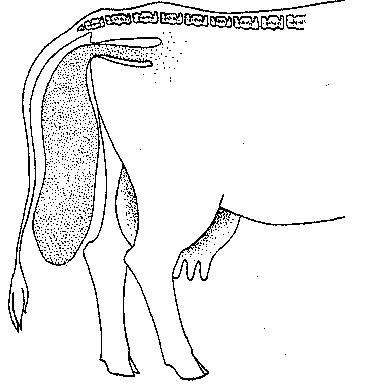
Figure 9. Uterine prolapse
Retained Placenta
A cow normally loses her afterbirth (placenta) within two to six hours after giving birth, A placenta which has not been passed by 12 hours is considered a retained placenta. If the cow shows no signs of illness (e.g., fever, off feed) there is little cause for alarm.
Most cows will expel a retained placenta within six to eight days after calving. Manual removal should be avoided to prevent excessive haemorrhage in the uterus or introducing additional infection into the uterus. The placenta is best left alone or simply cut off where it hangs out of the vulva. It is not recommended that uterine boluses be put into the uterus routinely as this may result in a delay of the decomposition of the placenta and, therefore, prolong its passage.
If an animal with a retained placenta loses her appetite or seems dull and lethargic, it may have an elevated temperature, Injections of an antibiotic should be given daily until her appetite is normal. Consult your veterinarian if she does not appear to be responding to treatment.
Source: Agdex 420/22-1. |
|